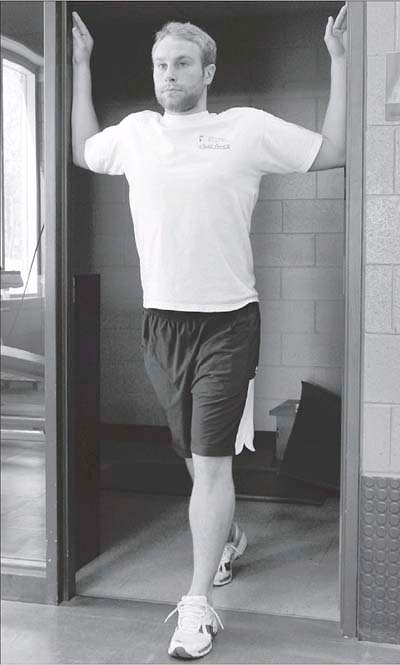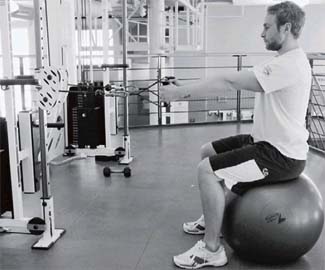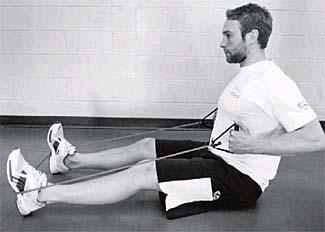Practice makes perfect postureBy JILL BARKER, The Gazette
|
 |
|---|
If it's any consolation, you're not alone. Every Canadian who spends time hunched over a computer, leaning over a desk full of work or carrying babies and toddlers is at risk of forgetting how to stand up straight.
But it's not just sedentary activities that cause posture to deteriorate. Too many bench presses, lengths of the pool and hours spent hunched over a bike can lead to tight chest muscles and weak overstretched back muscles.
Practice these bad habits long enough and squaring your shoulders becomes not just impossible, it's painful.
Fortunately, there are steps you can take to make things right and they start in the gym. First, take a look at your workout routine. A well-balanced training session focuses equal attention on the muscles of the posterior and the anterior. In other words every ab exercise should be matched by an exercise for the back. And every pushing exercise (bench press, push up) should be matched by a pulling exercise (a seated row or lateral pull down).
Once you have created better workout balance, it's time to improve your technique. The first tip is correcting the way you balance your body, which starts by pulling your head back in line with the spine with the ears stacked over the shoulders. That may sound easy, but most of us are in the habit of carrying our head too far forward, which is the start of a slouch that continues down the rest of the body.
 |
|---|
This new, improved head position needs to be maintained at all times, even during your workouts, which may mean frequent checks in the mirror to make sure your head is centred correctly over your body. Practise pulling your chin back several times a day to relearn a more balanced head position.
The next tip to better technique is to set your shoulder blades properly before starting an exercise. Perfect posture calls for your shoulder blades to rest comfortably on your back with their inner corners located about three inches from the spine. Compare that to shoulder blades that ride up and away from the spine with their outer corners rounding toward the front of the body.
Once you set your shoulders by sliding the shoulder blades down and closer together, the rest of your spine should stay in what's called neutral alignment that preserves the natural curve in your low back.
The next challenge is maintaining perfect posture while exercising. Constant self-reminders to lengthen the spine, press the shoulders down, slide the shoulder blades closer together (especially during movements where you raise your arms over head) and tuck the chin can help keep your body in good alignment through all phases of movement.
 |
|---|
Where are you most likely to go wrong? Elliptical exercisers often lead with their chins, runners swing their arms from shoulders held too high and cyclists have been known to lean over their bikes with curved spines and rounded shoulders. These postural mistakes become even more pronounced as you fatigue, so pay close attention to your posture during those final few minutes of your workout when you feel yourself getting tired.
As for weight lifters, rounding the spine instead of bending from the hips, flattening the low back instead of maintaining its natural curve and letting the head roll forward are all common postural mistakes made in the weight room.
To further help your posture, consider adding the following exercises to your workout routine. Designed to strengthen the upper back and stretch the chest, these exercises will make it easier to stand up straight. Follow the instructions carefully and make sure they become a staple of your workout. Better posture takes work, but it's worth it.
Strength Below are two versions of a row using dumbbells and exercise tubing, so you can practise in the gym or at home.
Be sure to keep your head centred over the spine, upper body long and a gentle curve in your lower back. Your spine stays stationary (don't lean forward or backward) through all phases of the exercise and your shoulder blades slide toward the spine during the "pulling" phase and back to their neutral position as your arms extend into the start position. Keep the elbows close to your body and palms facing each other while pulling. Repeat eight to 10 times.
Perform two to three times a week.
Stretch Stand just behind a door frame and place your forearms on the doorframe with elbows at shoulder height, as shown at left. Place one foot in front of the other and gently lean forward until you feel a gentle (you should feel tension not pain) stretch in your chest. Hold for 15 to 30 seconds. Rest and repeat two more times.
Perform daily.
Photos: Matt Potter demonstrates strength-building execises to improve posture that can be performed in the gym or at home.
[email protected]
© The Gazette (Montreal)

